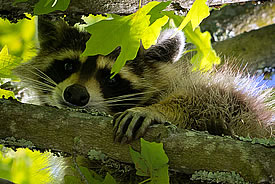The raccoon: A human’s perspective

Raccoon (Photo by Ken Thomas/Wikimedia Commons)
Most people who live in southern Canada have witnessed raccoons first-hand. However, due to the fact that they are usually observed tearing up garbage bins, they are often viewed with disdain. I must admit, although I love animals, there have been times when I have found raccoons to be more than a little bit trying, and thus I have never been really interested in them as a species.
This view changed a few weeks ago when I was at the zoo and happened to pass by the raccoon enclosure. For starters, I couldn’t believe that there were raccoons in the zoo. I mean, one was chowing down on my disposed orange peel last night! I also couldn’t believe that the raccoon’s animal description spoke of it having the potential to be an intelligent mammal. I had never really thought about raccoons as being intelligent, so this piqued my interest. When I went home, I did some research on raccoons, and uncovered some new information about these creatures that I had not previously known.
Raccoons as intelligent creatures?
Raccoons, as the zoo enclosure hinted, are intelligent creatures. Their intelligence first became a point of interest among psychologist in the early 1900s. At this time, raccoons were beginning to make a transition from being hunted for fur and game to being a more respected and successful animal. They had begun to flourish despite urban expansion, and having raccoons as a household pet was gaining in popularity. Looks like Carl Linnaeus, a famous biologist who lived in the 1700s and who had a pet raccoon, set a trend!
In 1907, however, psychologist Lawrence W. Cole discovered that they were no ordinary household pet, and were in fact more intelligent than cats or dogs. Cole performed a series of problem-solving experiments on raccoons that tested their ability to release themselves from various enclosures. Cole observed their memory and their ability to learn, and through his research, he surmised that raccoons had the same degree of intelligence as monkeys. This was a shocking discovery, as it helped to support the growing idea that animals could have the ability to be curious. Many psychologists were, however, suspicious of his findings, and questioned the validity of Cole’s research. For this reason, since Cole’s findings, research related to the intelligence of raccoons was has been conducted with little frequency. That is, until recently.
Raccoon nation
In 2011, The Nature of Things made a documentary that explored the intelligence of raccoons. Researchers working on "Raccoon Nation" realized that the more they studied raccoons, the less they understood them. This was because, as they discovered, raccoons are highly individualistic creatures; individuality being a trait that requires an animal to have reasonable decision-making skills.
During the development of the documentary, researchers placed various raccoons from Toronto in a natural area outside the city and monitored their behaviour and their ability to cope in a new environment. They expected the raccoons’ behaviour to be similar, however, much to their surprise, each raccoon behaved differently, displaying their individuality. In addition, researchers discovered that although raccoons do still live in their “natural” forested habitats, raccoons have actually thrived more in urban environments.
In fact, in some areas of Toronto, there are 150 raccoons per square kilometre of land! Raccoons have also thrived in other urban environments to which they have been introduced, such as in Japan, France, Russia and Germany. The researchers attributed the raccoons' success in urban locations to their ability to adapt to many environments, and to be able to consume almost any type of food, these attributes actually being similar to those of a human.
This documentary sheds new light on an interesting and clearly intelligent species.
Raccoons as pests
In more recent years, the number of raccoons in North America, Japan, and parts of Europe has been steadily rising. Due to the diseases they carry, and the destruction of infrastructure that they cause, they are now considered to be pests by humans.
This, however, is ironic, as raccoons have actually flourished mostly due to human activity. Due to the fact they are intelligent, and curious and have dextrous hands, they are able to take full advantage of the waste and resources that humans produce. They are able to break into garbage bins, houses, office buildings, agricultural land; you name it.
Raccoons are also not only an annoyance for humans, but also are a threat to the survival of many species. As animals who naturally consume small aquatic and non-aquatic animals, raccoons have now begun preying on threatened species. In Ontario and other provinces, raccoons consume bird eggs and young birds who they find in nests. They also prey upon turtle nests, and possibly snake nests as well.
When raccoons and conservation efforts collide
In southern Ontario, raccoons have especially had an impact on the spiny softshell turtle — a species that the Nature Conservancy of Canada (NCC) is working to protect.
In recent studies in Ontario, 100 percent of unprotected spiny softshell turtle nests being monitored were preyed upon by raccoons. NCC has been involved in protecting this species of turtle, by protecting and restoring their habitat, ongoing research and outreach programs. Unfortunately, these efforts have been slightly hindered by raccoons.
Raccoons may also contribute to distribution of invasive species seeds such as garlic mustard— an invasive plant species that NCC works to eradicate.
How can you help?
The long and short of it is, humans must learn to cease subsidising raccoons. This will encourage them to leave urban environments and to return to their natural habitat, and will help to gradually reduce the amount raccoon populations in urban areas — in turn minimizing their impact on at-risk species.
Humans provide food sources and shelter for raccoons, so there are many ways in which we can reduce the degree to which we subsidize them.
Some of these methods include:
- Never feeding raccoons in parks or on streets;
- Making sure to dispose of garbage properly, and not littering;
- Purchasing wires and special rubberized animal wires to secure garbage cans;
- Protecting vegetable and fruit gardens with wires and fences in order to deter raccoons;
- Capping chimneys and making sure that decks and attics are properly protected against furry intruders;
- Placing bird feeders in spots where raccoons can’t easily reach them, and bringing them in during the evening and night; and
- Locking pet doors at night.
See this website for some more suggestions:
Learning to live with raccoons
Raccoons are cunning, curious, adaptive, and intelligent animals, who deserve more respect from humans. Sadly, however, they are considered to be pests. Although their actions are having negative effects on wildlife in Canada and beyond, humans must understand that they are simply resourceful animals who are capitalising on the waste produced by humans.
Hopefully, through this blog post, you have been inspired to reconsider your previous view on raccoons, and to consider not only the wonderful success of this innovative animal but also the future of this species and those it preys upon if the actions of humans are not changed.
In addition, if you would like more information about raccoons in homes, gardens, or more please visit this website.


